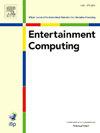Specification of users’ cognitive functions and emotions to promote their training through Serious games
IF 2.8
3区 计算机科学
Q2 COMPUTER SCIENCE, CYBERNETICS
引用次数: 0
Abstract
Serious Games are gaining recognition as a powerful tool to promote education, specifically in organizational training processes, to achieve effective learning. In these learning processes, individuals must acquire specific cognitive and affective capacities depending on the organization’s objectives, which should be acquired through serious games. However, creating games that effectively train cognitive and affective skills requires a methodological approach to seamlessly integrate specific educational content, game mechanics, story, aesthetics, technology, and assessment tools, among other things. This paper presents a cognitive-affective model for conceptualizing the design of serious games. The model comprises cognitive and affective dimensions, each with its graphical notation, components, and behaviour. The cognitive dimension is based on neuroscience and game mechanics research, while the affective dimension is drawn from affective computing. This paper shows how the cognitive-affective model can guide the development of games that facilitate continuous training and generate cognitive/emotional experiences in specific situations. A case study highlights the model’s effectiveness in a gas explosion simulation explicitly designed for the mining sector. The model enables designers to create games that train users in risky situations, improving their behaviour in simulated dangerous situations in a safe environment. The model’s effectiveness was validated in two ways: 1) with a virtual SG and 2) through competition questions, which showed promising results.
规范用户的认知功能和情绪,通过严肃游戏促进他们的训练
严肃游戏作为一种促进教育的强大工具,特别是在组织培训过程中,以实现有效的学习。在这些学习过程中,个人必须根据组织的目标获得特定的认知和情感能力,这些能力应该通过严肃的游戏获得。然而,创造能够有效训练认知和情感技能的游戏需要一种方法去无缝整合特定的教育内容,游戏机制,故事,美学,技术和评估工具等等。本文提出了一个概念化严肃游戏设计的认知-情感模型。该模型包括认知和情感两个维度,每个维度都有其图形符号、组件和行为。认知维度基于神经科学和游戏机制的研究,而情感维度则来自情感计算。本文展示了认知-情感模型如何指导游戏开发,从而促进持续训练并在特定情境中产生认知/情感体验。一个案例研究表明,该模型在专门为采矿业设计的瓦斯爆炸模拟中的有效性。该模型使设计师能够创造出在危险情况下训练用户的游戏,在安全环境中模拟危险情况,改善他们的行为。通过虚拟SG和竞争问题两种方式验证了模型的有效性,并取得了良好的效果。
本文章由计算机程序翻译,如有差异,请以英文原文为准。
求助全文
约1分钟内获得全文
求助全文
来源期刊

Entertainment Computing
Computer Science-Human-Computer Interaction
CiteScore
5.90
自引率
7.10%
发文量
66
期刊介绍:
Entertainment Computing publishes original, peer-reviewed research articles and serves as a forum for stimulating and disseminating innovative research ideas, emerging technologies, empirical investigations, state-of-the-art methods and tools in all aspects of digital entertainment, new media, entertainment computing, gaming, robotics, toys and applications among researchers, engineers, social scientists, artists and practitioners. Theoretical, technical, empirical, survey articles and case studies are all appropriate to the journal.
 求助内容:
求助内容: 应助结果提醒方式:
应助结果提醒方式:


